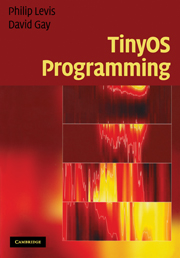Preface
Published online by Cambridge University Press: 05 August 2012
Summary
This book provides an in-depth introduction to writing nesC code for the TinyOS 2.0 operating system. While it goes into greater depth than the TinyOS tutorials on this subject, there are several topics that are outside its scope, such as the structure and implementation of radio stacks or existing TinyOS libraries. It focuses on how to write nesC code, and explains the concepts and reasons behind many of the nesC and TinyOS design decisions. If you are interested in a brief introduction to TinyOS programming, then you should probably start with the tutorials. If you're interested in details on particular TinyOS subsystems you should probably consult TEPs (TinyOS Enhancement Proposals), which detail the corresponding design considerations, interfaces, andcomponents. Both of these can be foundin the doc/html directory of a TinyOS distribution.
While some of the contents of this book are useful for 1.x versions of TinyOS, they do have several differences from TinyOS 2.0 which can lead to different programming practices. If in doubt, referring to the TEP on the subject is probably the best bet, as TEPs often discuss in detail the differences between 1.x and 2.0.
For someone who has experience with C or C++, writing simple nesC programs is fairly straightforward: all you need to do is implement one or two modules and wire them together. The difficulty (and intellectual challenge) comes when building larger applications. The code inside TinyOS modules is fairly analogous to C coding, but configurations – which stitch together components – are not.
- Type
- Chapter
- Information
- TinyOS Programming , pp. xvii - xviiiPublisher: Cambridge University PressPrint publication year: 2009

